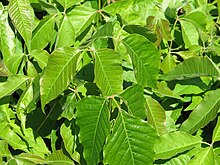| Toxicodendron radicans | |
|---|---|

| |
| Poison ivy during autumn | |

| |
| Poison ivy in spring, Ottawa, Ontario | |
| Scientific classification | |
| Kingdom: | Plantae |
| Clade: | Tracheophytes |
| Clade: | Angiosperms |
| Clade: | Eudicots |
| Clade: | Rosids |
| Order: | Sapindales |
| Family: | Anacardiaceae |
| Genus: | Toxicodendron |
| Species: | T. radicans
|
| Binomial name | |
| Toxicodendron radicans (L.) Kuntze
| |

| |
| Toxicodendron radicans range map in the United States and Canada | |
| Synonyms | |
| |
Toxicodendron radicans, commonly known as eastern poison ivy[3] or poison ivy, is an allergenic flowering plant that occurs in Asia and eastern North America. The species is well known for causing urushiol-induced contact dermatitis, an itchy, irritating, and sometimes painful rash, in most people who touch it. The rash is caused by urushiol, a clear liquid compound in the plant's sap.[4] The species is variable in its appearance and habit, and despite its common name, it is not a true ivy (Hedera), but rather a member of the cashew and pistachio family (Anacardiaceae). T. radicans is commonly eaten by many animals and the seeds are consumed by birds,[5] but poison ivy is most often thought of as an unwelcome weed. It is a different species from western poison ivy, T. rydbergii, which has similar effects.
- ^ Bárrios, S. & Copeland, A. (2021). "Toxicodendron radicans". IUCN Red List of Threatened Species. 2021: e.T124270453A192137361. doi:10.2305/IUCN.UK.2021-3.RLTS.T124270453A192137361.en. Retrieved 26 September 2023.
- ^ NatureServe (1 September 2023). "Toxicodendron radicans". NatureServe Network Biodiversity Location Data accessed through NatureServe Explorer. Arlington, Virginia: NatureServe. Retrieved 26 September 2023.
- ^ USDA, NRCS (n.d.). "Toxicodendron radicans". The PLANTS Database (plants.usda.gov). Greensboro, North Carolina: National Plant Data Team. Retrieved 11 December 2015.
- ^ Barceloux, Donald G. (2008). Medical Toxicology of Natural Substances: Foods, Fungi, Medicinal Herbs, Plants, and Venomous Animals. John Wiley and Sons. pp. 681–. ISBN 978-0-471-72761-3.
- ^ Department of Biology Hamilton College Ernest H. Williams Jr. Professor (26 April 2005). The Nature Handbook: A Guide to Observing the Great Outdoors: A Guide to Observing the Great Outdoors. Oxford University Press. pp. 57–. ISBN 978-0-19-972075-0.

